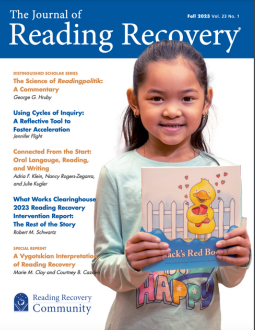A Synthesis of Research on Reading Recovery
Background
Shanahan and Barr published a comprehensive and independent evaluation of Reading Recovery. The goal of the authors was to offer a thorough, systematic analysis of all available empirical work on Reading Recovery. They reviewed all published evaluations and any available unpublished ones that included sufficient basic information to allow meaningful analysis. When possible to analyze data in a more precise and direct manner, data were combined across studies. Overall, consideration of existing research and evaluation studies was largely qualitative.
Findings
“Evidence firmly supports the conclusion that Reading Recovery does bring the learning of many children up to that of their average-achieving peers. Thus, in answer to the questions “Does Reading Recovery work?,” we must respond in the affirmative. It is clear that many children leave the program with well-developed reading strategies, including phonemic awareness and knowledge of spelling. Although some initially low-achieving students will succeed without Reading Recovery, evidence indicates that many who would not succeed do so as a result of this intervention.” (p. 989)
“That Reading Recovery has been so successful is laudatory. It has proven to be a robust program, both in terms of its consequences for student learning and in replicability across sites. Further, it has been a significant force in shaping the way we view early literacy development.” (p. 992)
Comments
This review provided perhaps the most comprehensive independent evaluation of Reading Recovery up to its 1995 publication. Authors cited both caveats and challenges for consideration related to research and to practice.
Authors of a statewide study (Pinnell, Lyons, DeFord, Bryk, & Seltzer, 1994) responded to Shanahan and Barr’s claim that half the data from the study had been lost. Pinnell explained in a letter to the editor of Reading Research Quarterly, [see 32(1), p. 114] that only 5 of the 40 schools were excluded and provided the rationale. Shanahan and Barr responded to Pinnell in the same publication.
Parts of this study abstract appear in B.J. Askew, I.C. Fountas, C.A. Lyons, G.S. Pinnell, & M.C. Schmitt (1998). Reading Recovery Review: Understandings Outcomes & Implications, p. 23. Columbus, OH: Reading Recovery Council of North America.
THE JOURNAL OF READING RECOVERY
Fall 2023
The Science of Readingpolitik: A Commentary by George G. Hruby
Distinguished Scholar Series: A Vygotskian Interpretation of Reading Recovery by Marie M. Clay and Courtney B. Cazden
Using Cycles of Inquiry: A Reflective Tool to Foster Acceleration by Jennifer Flight
Connected From the Start: Oral Language, Reading, and Writing by Adria F. Klein, Nancy Rogers-Zegarra, Julie Kugler

